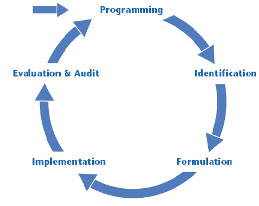A programme is the response by an organization to the need of concretizing its mission into a series of actions. It is a framework containing planned activities (projects) directed towards a common (overall) goal.
Each program must start with an assessment of the beneficiary needs, their expectation and their rights. The goal of the programme represents the response to problems identified in the needs assessment (during identification phase) and is the common overall objective of the various projects. The response strategy is always defined in line with EU development policy priorities – as outlined in the European Consensus on Development and other documents – such as alleviating poverty, promoting sustainable development, increasing aid effectiveness and achieving the UN’s Millennium Development Goals. Every effort is also made to ensure that the strategy is coherent with other relevant EU policy areas (trade, the environment, migration, employment and social cohesion, agriculture, etc.).
During the programming phase, the situation at national and sectoral level is analysed to identify problems and constraints, and an EU response strategy is established for EU cooperation. This involves a review of socio-economic indicators, and of the priorities of the EU, its partner countries and other donors. The purpose is to ascertain the main objectives and sectoral priorities for cooperation so as to provide a relevant and feasible framework within which programmes and projects can be defined and prepared. The relevance of this framework is regularly reviewed during Mid Term and End of Term Reviews.
A programme is the response by an organization to the need of concretizing its mission into a series of actions. It is a framework containing planned activities (projects) directed towards a common goal.
This programme goal represents the meeting ground between the organization's mandate and the needs (including the need to recognise and exercise their rights) of the people for whom the organization works. That is why in the development and humanitarian aid sectors each program starts with an assessment of the beneficiary needs, their expectation and their rights. The goal of the programme represents the answer by the organization to the problems identified in the beneficiary needs assessment (during programme identification phase) and is the common overall objective of the various projects.
Programmes identify development needs and set overall objectives to be achieved in order to respond to those needs. Programmes are implemented through actions that address specific programme areas. These actions, i.e. these programme components, are also called "projects", because their objective is specific, their scope is limited and because they are terminated once the expected outputs are delivered. Programmes instead have a wide scope and are not specifically time bound.
While projects tend to proceed along a linear path ... from its conception to its closure, programmes tend to follow a cycle process, where the lessons learnt in the implementation of a plan feed into the identification and designing of a new phase of the programme or a new programme.


program stages
Like in the case of the project stages also the programmes move through origination, initiation, planning execution, evaluation and eventually closure. But unlike projects, that are temporary efforts aimed at early closures, programmes move through renovating and redesigning cycles constantly regenerating new projects that addresses newly identified problems and opportunities. So while projects stages tend to proceed along a linear path ... from its conception to its closure, programmes tend to follow a cycle process, where the lessons learnt in the implementation of a plan feed into the identification and designing of a new programme. Each programme circle starts and ends with an evaluation of the beneficiary needs for further programme design and development.
Actions produce results: in order to produce better results we need to improve the management of actions. Therefore managing programmes implies to understand the correlation between the way actions are managed and the way the life quality of the beneficiaries changes as result of the actions performed. This means on the one hand learning how to improve the capacity to respond appropriately to the needs of the beneficiaries; an on the other hand, learning how to improve the capacity to generate a sense of team partnership within the organization and externally with the programme/project partners.
Program management is the process of managing multiple inter-dependent projects. It includes co-ordination in designing, implementing and evaluating the projects.
The "programme plan" is a document that indicates a broad framework of goals to be achieved, serving as a basis to define and plan specific projects.
Organizations that concretize their mission into programmes that are implemented through projects are called "projectized organizations".
 Politically correct:
Politically correct: